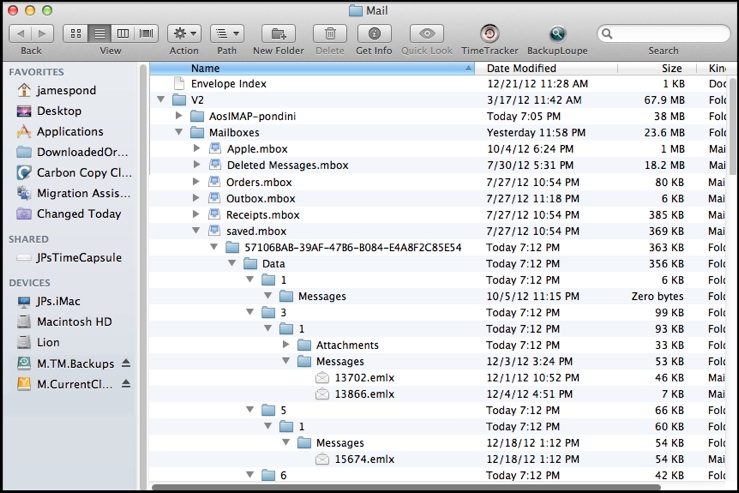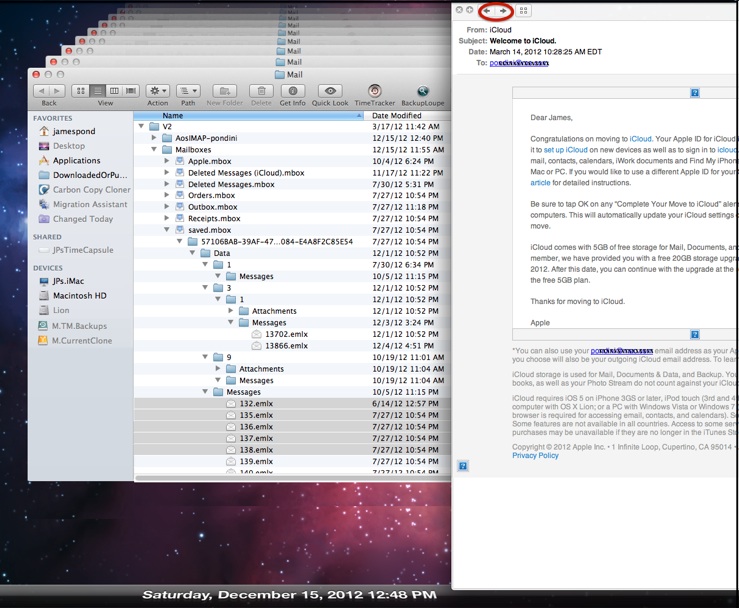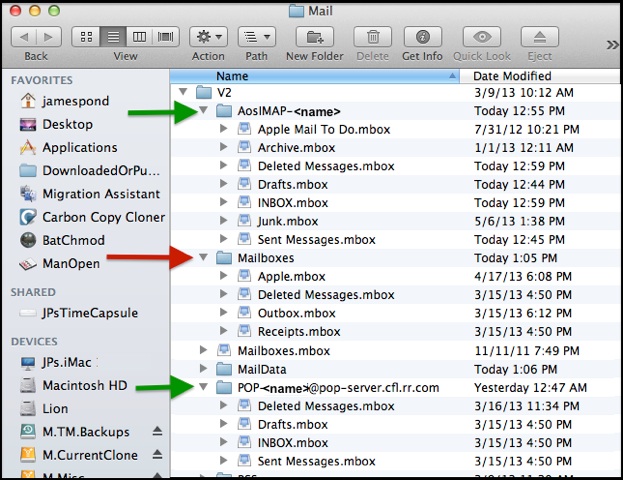Time Machine - Troubleshooting
E11. Can't see old backups via Mail (on Mountain Lion)
Time Machine - Troubleshooting
E11. Can't see old backups via Mail (on Mountain Lion)
The special Mail > Time Machine display on Mountain Lion won't display emails from backups made on earlier versions of OSX. The display (per the blue box in Time Machine FAQ #15), shows the old backups in the TimeLine on the right, but they're faded-out and you can't select them.
We're hoping for a fix from Apple, but in the meantime, we have developed a couple of workarounds -- unfortunately, they're rather tedious.
They both involve using the Finder > Time Machine interface instead of the Mail > Time Machine display. The problem is, the way emails are stored makes it extremely hard to tell what's what via the Finder. You can't see anything, such as sender, subject, or date via the Finder (that's why there's a separate Mail > Time Machine interface).
Browsing messages first: Inside each account and Mailbox folder is a whole series of folders inside folders, which, eventually, contain one named Messages, some of which will contain one or more files named <number>.emlx. Each of those .emlx files contains a single email; obviously, there's no easy way to tell what's in them, or who sent them, or when, etc.
1.The best way to "home in" on what you're looking for is to use the Last Modified date (and/or the Created or Last Opened dates) on the email files. If the column(s) aren't shown on the Finder window, select View > Show View Options from the menubar, and select the one(s) you think will help you locate the desired emails. You can move the columns around by dragging the headings. The result should look something like this:

Note that the saved mailbox in the sample has some empty Messages folders, and others with one or more .emlx files.
Now, Enter Time Machine:
2.Once you have the window the way you want it, click the Time Machine icon in your Dock or select Enter Time Machine from the Time Machine icon in your menubar. Using the TimeLine on the right, navigate to and click on a backup that ought to have the message(s) you're looking for.
3.Open the folders in the account or mailbox folders you expect to contain the desired message(s), until you get to a Messages folder with some .emlx files. Note that depending on the type of mailbox (IMAP or POP), and some of Mail's preferences, there may be multiple mailboxes with the same name, including some in the account folders and the Mailboxes folder.
4.Select one or more of the files and control-click (right-click) and select QuickLook. (Note that you can select a large group by clicking one, then holding the Shift key while selecting another -- that will select all the items between the two.) You'll get something like this:

If you selected more than one .emlx file, you can use the arrows at the upper-left of the QuickLook window to move up or down in the list without having to select each in the list.
Also note that you can move the QuickLook window around.
5.If you find the message(s) you want, do not use the normal Restore button to restore to the original mailbox, as that won't update the indexes and they won't appear in the Mail display.
6.Instead, control-click (right-click) it/them, select the Restore <items> to.. option, and select a temporary location such as your desktop as the destination. That exits from Time Machine automatically.
7.Select File > Import Mailboxes from the Mail menubar, select Apple Mail, click Continue, then select the restored message(s). That will import them into a mailbox in an Import mailbox in Mail. You can then move them to other mailboxes as desired.
•The green box below shows how to restore an entire mailbox from a selected backup. The downside is, you can't browse it beforehand to see if what you're looking for is actually there -- you can only do that after recovering the entire mailbox.
•The blue box below shows how to see individual messages directly in a selected backup, then once you locate what you're after, recover only those messages. The downside to this one is, you may have to look in several places.
Recovering an entire mailbox
1.Once you've located the mailbox(es) you want to restore (in the Finder window above), Enter Time Machine and locate the backup you want via the TimeLine on the right. Then select the desired mailbox folder(s) and control-click (right-click) or click the "gear" icon in the toolbar, then select the Restore <items> to.. option, and select your Desktop as the destination. Do not click the normal Restore button at the lower right!!
That will place the selected folder(s) on your Desktop and exit from the Time Machine browser.
2.Now go to your normal Mail window. From the menubar, select File > Import Mailboxes...
3.On the Import window that brings up, Apple Mail should already be selected. Click Continue.
4.Select the mailboxes you just restored to your Desktop and click Choose.
5.That will create a new mailbox folder named Import in the On My Mac section; inside it will be a folder for each recovered mailbox.
6.You can browse, delete, or move the messages in that mailbox normally.
Before starting either method, you need to get your current Mail folder shown in a particular way in a Finder window.
Mail data is stored in the <your home folder>/Library/Mail folder. Unfortunately, Apple hides it from you.
1.Open a Finder window. Hold the Alt/Option key while selecting Go in the menubar, then select the Library entry. Once that's displayed, locate and double-click the Mail folder inside it. That should show only the Mail folder in a Finder window. This is the one you'll be working with.
2.Put the Finder window into List View by selecting View > As List from the menubar. You can see the contents of a folder by clicking the "disclosure triangle" in front of the folder name.

There's a folder for each e-mail account (green arrows) containing a folder for each mailbox in that account.
There's a separate folder (red arrow) for On My Mac mailboxes.